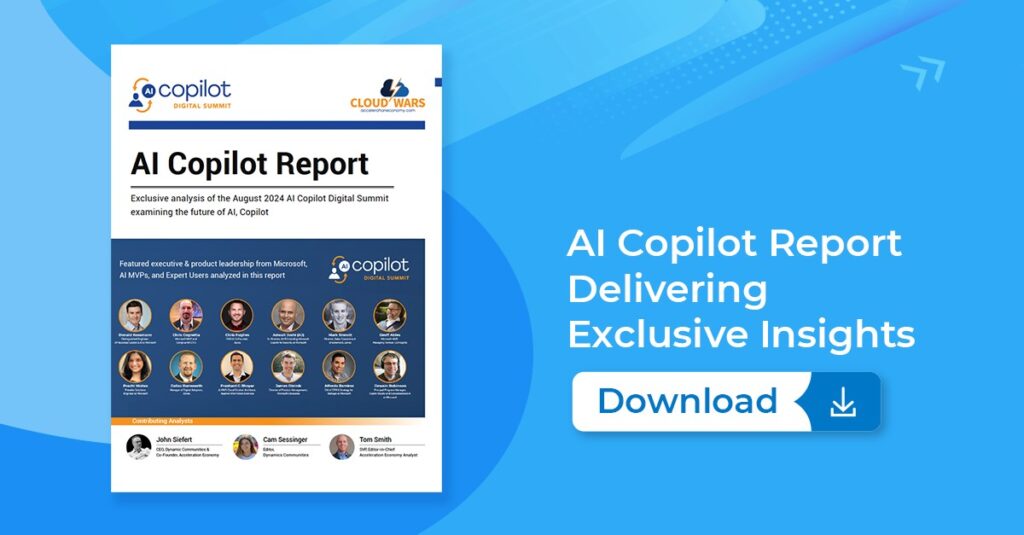
If you love big ambition and big dreams —and those are, after all, the animating forces behind the Cloud Wars — then you’ve gotta love Bill McDermott’s vision for tripling the size of ServiceNow from its current run rate of about $11 billion to his newly stated goal of $30 billion.
Well, I guess you can’t be expected to express too much love if you’re a competitor or soon-to-be competitor because ServiceNow’s market momentum and strategic ambition are surging, and McDermott has the look of a cat who’s eyeing a roomful of canaries.
As he begins his sixth year atop ServiceNow — and yes, can it really be five years already since he left SAP to join then-tiny ServiceNow? — McDermott used the company’s recent Q3 earnings call to describe the market opportunity that he sees and the hunger he and his company feel.
“ServiceNow is putting AI to work for people. Our world forum events are oversubscribed and in some cases we’ll more than double the attendance year over year,” McDermott said as he wrapped up his opening remarks on the call during which he noted that Q3 subscription revenue rose 22.5% and total RPO jumped 33%.
“By definition, a safe haven is a place of refuge for security. By virtue of our team, our technology, and our strategic choices, no company is more closely aligned to where our customers need to go.
“And that not only makes us a safe haven for customers, it also fuels our rocket ship to hit new milestones as we grow to $30 billion and beyond.”
Ask Cloud Wars AI Agent about this analysis
McDermott is clearly counting on many factors that will combine to enable ServiceNow to reach that big number, but from his remarks during that Q3 earnings call I’ve pulled out four reasons that I feel are and will be strategically vital in reaching that goal.
1. Hypergrowth Now Assist agents become super-agents. Calling its Now Assist portfolio “our fastest-growing product ever and an accelerant to our cross-enterprise expansion,” McDermott said 44 customers are spending more than $1 million per year on Now Assist, including six who are spending more than $5 million and two who are topping $10 million. With ServiceNow’s new Xanadu GenAI release, Now Assist can handle analytics generation, custom skills development, security, procurement, and software development. Plus, McDermott said, it’s being tailored for industry-specific automation in telecommunications, tech, public sector, banking, insurance, and manufacturing.
“Until now, generative AI in the enterprise requires human prompts to initiate action. We’re now deploying autonomous AI agents that work with people, not just for them,” McDermott said. “We intend to be the control point that governs the deployment of agentic AI across the enterprise.”
2. ServiceNow is pivoting to data, Part 1: Raptor DB. McDermott described the company’s first entry into the database market as being “built for AI-first enterprises” and claimed it “processes transactions 12X faster and analytics 27X faster” — but he did not specify versus what. “We already have great companies like Amadeus that have adopted RaptorDB and we’re counting on hundreds more.”
3. ServiceNow is pivoting to data, Part 2: Workflow Data Fabric. Where ServiceNow’s leap into the database and data-management category gets even more interesting is the launch of the Workflow Data Fabric as the aggregator of all the stuff that feeds into RaptorDB. McDermott teed it up this way: “We are expanding deeper with our new Workflow Data Fabric, which will unify business and technology data so it flows seamlessly across the enterprise. Companies have always trusted us to bring order to the chaos of 20th-century enterprise architectures. Now we can do the same with their data by powering automation and AI with real-time secure access to data from any source. Workflow Data Fabric also includes zero copy partnerships with established leaders like Databricks and Snowflake so customers can turn data into instant AI-powered action, all on the ServiceNow platform.”
4. ServiceNow’s biggest product will be Customer Workflows. Over the past year, McDermott has on a few occasions said he sees a big opportunity for ServiceNow to disrupt and modernize the traditional CRM space. But on last week’s earnings call, he blew past those earlier references by saying, “I have a feeling that [Customer Workflows] will end up being the biggest business in ServiceNow.” So why does he feel that way?
“Customer workflows were in 15 of our top 20 Q3 deals and it was very, very strong. We grew net new annual contract value over 50% — that’s 5-0 percent — and had fantastic performance by our industry SKUs,” McDermott said. Those industries include managed services, manufacturing, semiconductors, medical devices, chemicals, and public sector. For ServiceNow’s tech and media business unit, revenue for Customer Workflows grew by more than 300%, McDermott said, while the company’s sales and order-management product was up more than 60%.
“It’s extremely, extremely exciting,” McDermott said, “and I think the idea of our value proposition comes down to sales productivity. Just think about reduced time to quote higher deal sizes, lower fulfillment time, zero-touch provisioning, optimizing for customer lifetime value. All this is resonating with the market in a big, big way.”
Final Thought
As I said near the top, there are lots and lots of drivers behind ServiceNow’s ongoing growth, but these four stood out to me as a long-time observer of McDermott and ServiceNow as the most essential ingredients for fulfilling McDermott’s vision of $30 billion in annual revenue.











